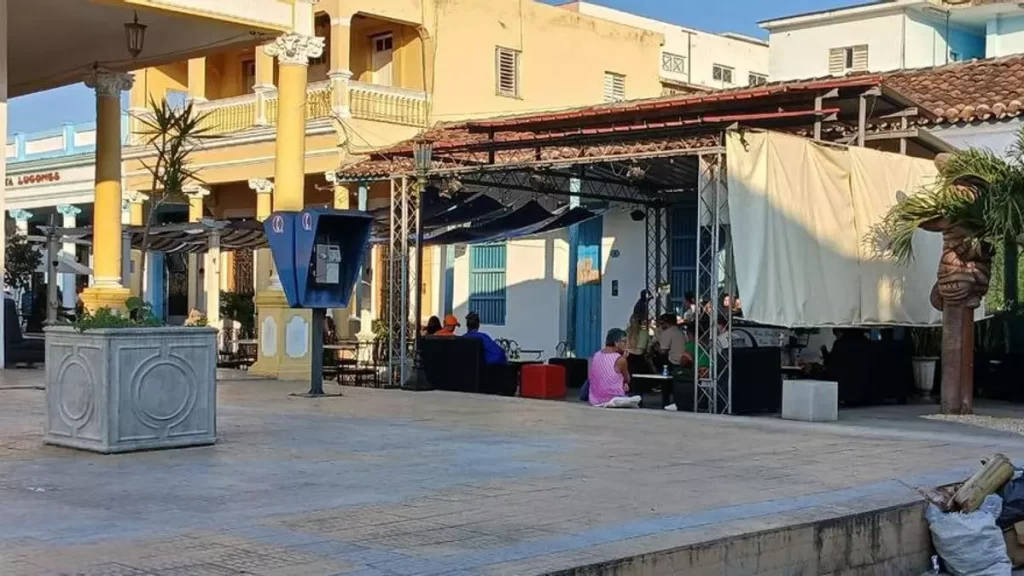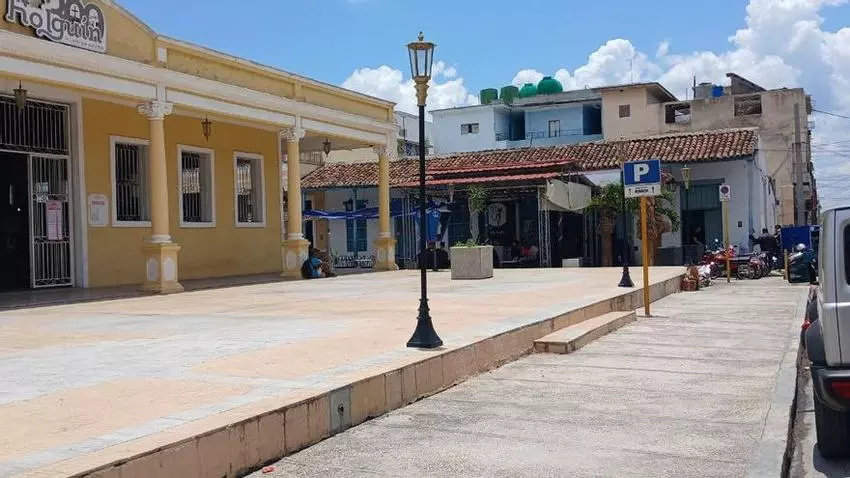In the so-called “market alley” there are, from Mártires to Gómez, Rhino’s Bar, Benjuly, Gato Negro and Destellos Café, all private

![]() 14ymedio, Miguel García, Holguín, May 18, 2024 — Mártires Street and three avenues named after heroes – Martí, Máximo Gómez and Luz y Caballero – frame the brand new red light district of Holguín, Cuba: Plaza de la Marqueta. In the old colonial market, restored several years ago, coming together are the prostitutes, their clients, local millionaires, scammers of various kinds and several yarinis* — named in honor of the mythical Havana pimp — who do not lose sight of their employees.
14ymedio, Miguel García, Holguín, May 18, 2024 — Mártires Street and three avenues named after heroes – Martí, Máximo Gómez and Luz y Caballero – frame the brand new red light district of Holguín, Cuba: Plaza de la Marqueta. In the old colonial market, restored several years ago, coming together are the prostitutes, their clients, local millionaires, scammers of various kinds and several yarinis* — named in honor of the mythical Havana pimp — who do not lose sight of their employees.
A decade ago, the tenants of the square – the center of Holguín life in Republican times – were very different. “Beggars who urinated and defecated,” recalls Heriberto, an employee in one of the bars that Marqueta enjoys today, taking advantage of the abandonment and ruin. The change from a homeless shelter to a brothel does not seem to have been too radical, he believes.
In the past there were shops, inns, butcher shops and fishmongers in La Marqueta. Now, however, the cartography of the square is made up almost exclusively of “upscale” bars and restaurants, at whose tables no one sits without knowing what’s happening. “They,” says Heriberto, referring to the prostitutes – who “are always groomed and well dressed” – “make their clients sit in a bar and consume.”
The cartography of the square is made up almost exclusively of “upscale” bars and restaurants
The price, depending on the services requested by the client, ranges between 3,000 and 5,000 pesos. Having a drink at the bar, explains Heriberto, is a kind of rite of passage or “password” to close the deal. “I don’t know if the owners of the establishments have any business with the yarinis, but that’s always the case,” he adds.
The Police know it, of course. From the red light districts of Havana – the same ones that made Alberto Yarini famous — his wars with rival pimps cost him his life in 1912 – to those of Santiago or Camagüey, passing through the nooks and crannies of El Condado Santa Clara, the Police always know and don’t get involved. “It’s a complicated territory,” says Heriberto, and not only because everything happens in bright sunlight and in a busy place, but because prostitution is just the tip of the crime iceberg.
Marijuana growers and their traffickers also visit La Marqueta, each with their own well-defined signs and rates; the cardholders, who know the techniques to steal currency from the MLC (freely convertible currency) cards of absent-minded or drunk clients; businessmen who prefer to discuss their sales with a beer in hand; and, from time to time, a train of tourists, who approach the chairs and bars without the slightest suspicion of what is taking place there.

Drinks and a Cuban version of tapas, that is the food available at the “little tables” of La Marqueta. In the so-called “market alley” – the backbone of the square – from Mártires to Gómez, there are Rhino’s Bar, Benjuly, Gato Negro and Destellos Café. They are all, says Heriberto, managed by private parties.
Each one has a group of burly guards, who take turns guarding the area around the square. Security is essential, as several businesses in Havana have demonstrated, exposed not only to problematic customers but also to “ninja” children, who steal to survive. Sometimes business gets out of control and a fight breaks out. “There haven’t been many fights, but what there was was loud and the ’boys’ had to intervene,” says Heriberto. Bosses do not like to be caught off guard by conflict and that is why they have constant surveillance. “Some have up to five guards working,” he says.
About the owner of Benjuly, Julio César Paredes – a “young and enterprising owner,” according to his website – there is a rumor: his alleged friendship with Lis Cuesta, wife of Miguel Díaz-Canel, who is attributed to being a “godmother,” or owner of the bar. This protection is what keeps its operation free of obstacles, assumes Heriberto, who assures that the same protection as above exists at the Bodegón Holguín, a business located on the Central Highway.
What started here has already spread to other areas, such as Pueblo Nuevo, and cases of drug sales have been detected
What started here has already spread to other areas, such as Pueblo Nuevo, and cases of drug sales and “strange” businesses have been detected in two high schools: Alberto Sosa and José Miró Argenter. But the center of the hurricane remains the square.
When the sun goes down and the city streets are not so hot, the young people of Holguín also go to Marqueta. Dressed up and careful not to invade other people’s territory, the prostitutes take their seats. The yarini sip their drinks and the card holders go into action. Cornered and trying to be discreet, the addicts begin to light their cigarettes. “The only thing missing is for El Químico** — the chemical — to arrive,” laments Heriberto, alluding to the fashionable drug in Havana. “It’s just a matter of time.”
Translator’s notes:
*Yarini: Alberto Yarini, Cuba’s most famous pimp, was murdered in 1910, and has featured in novels, films and song.
**El Químico: A very cheap drug, marijuana- or synthetic marijuana-based and laced with other substances. See here.
____________
COLLABORATE WITH OUR WORK: The 14ymedio team is committed to practicing serious journalism that reflects Cuba’s reality in all its depth. Thank you for joining us on this long journey. We invite you to continue supporting us by becoming a member of 14ymedio now. Together we can continue transforming journalism in Cuba.
